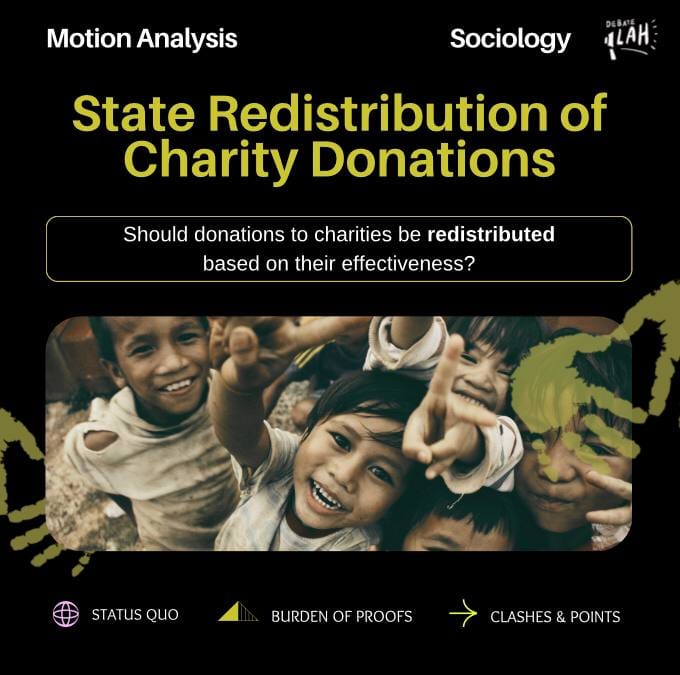Charities
Charities are organisations set up to provide help and raise money for those in need. These charities exist in forms of non-profit organisations, private organisations or are government-owned. Donations charities receive are usually tax-exempted, and play significant roles in filling gaps governments fail to address or provide service in.
With social issues needing funding and aid more than ever, charities must work efficiently to play their role in helping the needy. However, would redistribution of charity donations mean high efficacy in providing aid? Or would it be something harmful to allow state governments to do? With additional analysis from us, let us discuss the motion:
This house believes that states should reclaim a large proportion of all donations to charities and redistribute it across charities on the basis of their effectiveness.
This motion brings awareness about the urgent need to aid societal issues. Let us know whether you think states should redistribute charity donations!
Status quo: Ineffective Use of Charity Funds
Large donations received by charities are not efficiently used to solve social issues. There exists give well, effective altruism communities and academics to research the efficacy of charity organisations and programmes, but charities' finances are private and unaccountable to the public. Famous charities with large public appeal and bloated bureaucracies receive the most donations even though they are not the most effective at aiding the causes they claim to.
Allowing state governments to redistribute charity funds, however, is a potential solution to misuse of funds that hinder aid being provided to the needy. There comes the question of whether state redistribution of charity donations is the best way to ensure social justice is served.
With potential issues of allowing states to allocate funding to charities deemed effective in aiding social issues in mind, the debate then becomes about whether donations to charities should be redistributed by state governments based on their effectiveness.
Proponents of state redistribution of funds would argue that state redistribution of charity donations increases efficacy of using funds to increase impact on societal issues.
Opponents of state redistribution of funds would argue that states are inefficient in appropriately allocating funds to charities and that it would be better for charities to manage their own funding.
Mechanisms
Proponents would set up an independent third-party organisation that evaluates non-profits on their cost-efficacy and quality adjusted life (number of years of life people gain and significance of improvement of people's lives after receiving charity aid). They would also set up independent auditing of charities' finances and operations and force charities to disclose their finances to the public. Charities with worse cost efficacy and quality adjusted life will have its donations allocated to more effective non-profits that focus on the same issues. Donations will be allocated to charities that solve similar issues if it is not possible to find a charity that solves the exact same issue. Fund allocations are managed by the government of the place where the non-profits are founded.
Opponents would use taxation to create welfare schemes will be used to solve critical but neglected societal causes. They would also robustly regulate charities by mandating them to release all their financial records to respond to freedom of information requests and banning misleading advertisement. However, opponents would not evaluate a charity's efficacy in aiding social issues, but would provide metrics for donors to decide which organisations to contribute to. Opponents would additionally support third party charity watchdogs compiling metrics for the public.
#1 Efficacy vs Freedom of Choice
Proponents incentivise charities to take action. This is because most effective charities structurally tend to be smaller and are more principled. It is less likely for effective charities to focus on achieving large public appeal; rather, they would focus on taking action to provide aid to the needy. These organisations are not getting recognition and their reach is limited as they're not expanding staffing to ensure maximum outreach to the public. Proposition redistributes donations to smaller charities and gives them recognition and validation of their efficacy subject to state independent boards. Besides that, proposition provides huge incentives for larger charities that have large funding to improve their operations. For one, there is more transparency as fund management of charities is made public and people can understand where their finances are going to determine their efficacy. For two, proposition gives charities an active reason to cut down on bureaucracy and costs that decrease efficacy. This also incentivises donors who donate large sums of money to pressure non-profits to improve so the donations would not be allocated to other charities instead. Thirdly, proposition provides actual metrics for evaluation of the efficacy of charities. This creates competition between non-profits, which in turn creates efficacy and encourages productivity.
Opponents argue that this mechanism would undermine individual autonomy. They believe that donations are a morally praiseworthy act and not a moral obligation. Taxation of citizens already fulfils their moral obligation to help the vulnerable. Therefore, donating is beyond what people are expected to do and is not bound to any restriction. Opposition argues that efficacy to restrict donations is problematic as efficacy does not equate to the importance of charities. This would only discredit the work of charities and choices of the public to donate. Moreover, this is money individuals fundamentally have autonomy over to help society, their choice cannot be controlled and not donating to the most effective charity is not a moral blame they can be ascribed with.
#2 Charities' capacity to provide aid
Proponents say that they improve charities' capacity to act on social issues. They claim that fund allocations are unproductive and overflowed to the same charities that do not ensure proper use. Donations are most relevant in cases of emergency when charities are needed the most and in times of urgency when an average individual is most likely to donate, for example after natural disasters occur or during times when non-profits are in high demand. However, in the event of disasters we often donate to the charities we’re the most familiar with. Proposition believes that smaller local charities would be better at using funds productively as, being accustomed to having to wisely use limited funds before this, would not waste it on bloated bureaucracies and other unnecessary costs. With this, local lesser known charities that effectively target local issues will get funds. On top of that, proposition has a diverse advocacy as they would fund different charities that effectively target the same problems instead of same charities getting consistently overfunded and ineffectively using those funds. Even if there’s a marginal decrease in funding, charities targeting key causes effectively get the funds and allocation of funds is productive.
Opponents claim that this mechanism reduces the amount of donations charities get. It is counterproductive for governments to remove the autonomy people have over their donations. One reason is most people would become unwilling to donate as their money might not stay with the organisations or causes they care about. Additionally, smaller or less effective charities now lack crucial funding to promote awareness about their case. The majority of individuals do not know the majority of charities outside of ones they’re personally linked to, therefore outreach is important for awareness about a charity’s causes. For example, rare disease charities would be forgotten in proposition’s world as these charities would die off being forgotten by the public or because they lose their ability to help the needy.
#3 Impacts of Allowing States Authority to Redistribute Funds
Proponents state that the redistribution of donations is a fair mechanism as charities are fundamentally creatures of the state which gives the state significant control over them. Not only do states provide large subsidisation to charities by making donations tax deductible, states also provide regulatory compliance to charities, making it easier for them to control for legal liability. Governments give artificial legal and financial subsidy to charities in recognition of the good they do; therefore a reciprocal relationship should be established when the state subsidises charities so they can fairly demand things in return, that being the allocation of donation funds to how the state sees fit.
Opponents suggest that state redistribution allows states with nefarious intents to seize funds on political grounds. It complicates the procedure of giving help to those who are urgently in need. Their reason to believe this is threefold; firstly, charities are supposed to pick up where governments left off. Defunding or redirecting funds from important charities occurs when metrics and evaluations on the efficacy of charities are published on proposition side. Secondly, less important charitable causes or those that are smaller in scale decreases economic effectiveness as higher fixed costs and lower marginal costs have to be dealt with. Lastly, governments are not effective in dealing with such bloated bureaucracies or fund allocations in general. Overall, state redistribution may not work the way it was intended to; rather, it can backfire on the original purpose of charities.
Burden of Proofs
After understanding what state redistribution of charity funds looks like on both sides, we encourage you to think through what each side has presented in defense of their stance.
Proponents should prove that the redistribution of funds makes charities efficient in aiding social issues.
Opponents should prove that the redistribution of funds is harmful and allowing each charity to manage their own funds would better aid social issues.
Should donations to charities be redistributed based on their effectiveness? Would state redistribution of funds increase the efficacy of charities tackling societal needs? Or would it result in worse allocation of funds and decrease of donations?
That was a detailed analysis!
Here's a document that provides a deep analysis on all you need to know about understanding both ends of the topic at hand.
You may use this for mock debates, or just to develop an understanding of charities and their efficacy in responding to societal needs by properly using donations!
The efficacy of charities is a topic that is seldom discussed, so we've given you some relevant resources below to help you better understand the topic!
- How much of the donations actually go to benefit their causes?

- Bureaucracy in charities

And lastly, credits to Team Canada and Team Singapore of WSDC 2020 for the amazing debate!
https://www.youtube.com/live/Jx28K-AH3OY?si=puuPQvbvhpuvJLCY
Authors: Jacquelyn Hon, Chloe Koh



